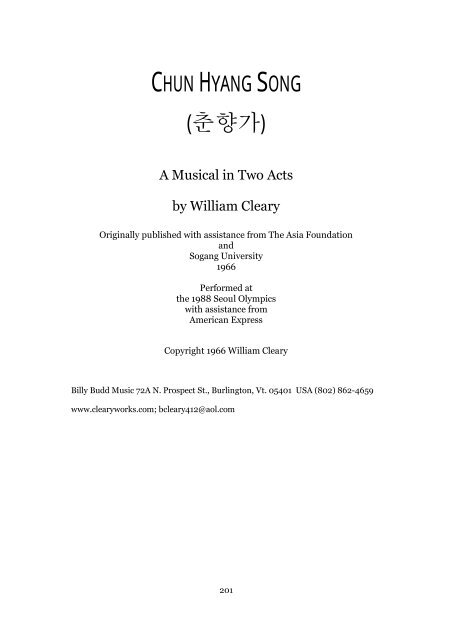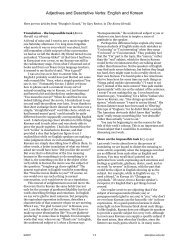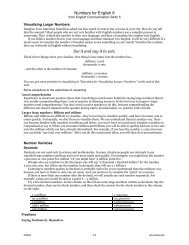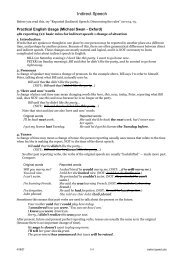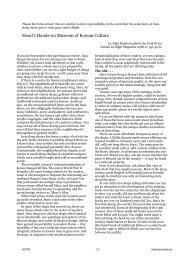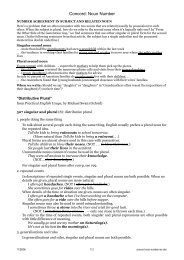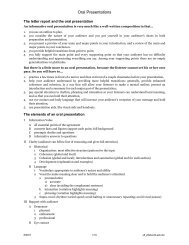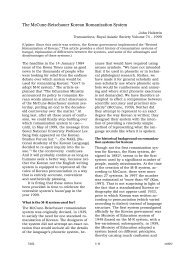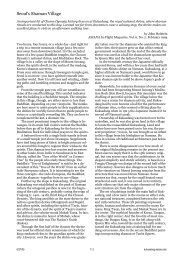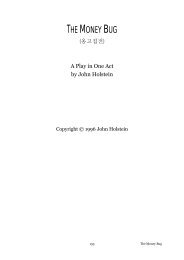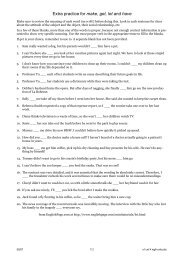You also want an ePaper? Increase the reach of your titles
YUMPU automatically turns print PDFs into web optimized ePapers that Google loves.
CHUN HYANG SONG<br />
(<strong>춘향가</strong>)<br />
A Musical in Two Acts<br />
by William Cleary<br />
Originally published with assistance from The Asia Foundation<br />
and<br />
Sogang University<br />
1966<br />
Performed at<br />
the 1988 Seoul Olympics<br />
with assistance from<br />
American Express<br />
Copyright 1966 William Cleary<br />
Billy Budd Music 72A N. Prospect St., Burlington, Vt. 05401 USA (802) 862-4659<br />
www.clearyworks.com; bcleary412@aol.com<br />
201
Scenes and Songs<br />
Overture Scene “If I Look Once”<br />
ACT ONE<br />
Scene One: The Pavilion at Namwon<br />
“Spring Song for Dano”<br />
“Butterflies”<br />
Scene Two: Yi Mong Yong’s Room<br />
“She’s Everywhere”<br />
Scene Three Chun Hyang’s Home<br />
“For Only a Hundred Years”<br />
Scene Four Behind Chun Hyang’s House<br />
“Stars in Your Eyes”<br />
“If I Look Once,” reprise<br />
Scene Five A Hilltop, Evening<br />
Scene Six The Same Hilltop, Morning<br />
“Sobangnim”<br />
“Wolmae’s Song”<br />
INTERMISSION<br />
ACT TWO<br />
Scene One: The Governor’s Palace<br />
“No Finer Ruler”<br />
Scene Two: The Prison<br />
“I Remember Well” (<strong>Korea</strong>n Sijo Poetry)<br />
Scene Three: Along the Road<br />
“Nongbu-ga”<br />
Scene Four: The Prison<br />
“Sobangnim,” reprise<br />
Scene Five: Chun Hyang’s Home, an Hour Later<br />
“Stars in Your Eyes,” reprise<br />
Scene Six: The Governor’s Palace<br />
“No Finer Ruler,” reprise<br />
“Poor Men”<br />
“Finale”<br />
A Yang for Every Yin 202
Cast<br />
The main characters (in order of appearance):<br />
Bang Ja: Mong Yong’s witty servant boy<br />
Mong Yong: an arrogant young nobleman<br />
Byon Satdo: a provincial magistrate, a fierce tyrant<br />
Wolmae: Chun Hyang’s petulant, talkative mother<br />
Hyang Dan Chun Hyang’s sweet, gentle servant girl<br />
Chun Hyang a strong, heroically loyal young woman<br />
Pronunciation<br />
Namwon, Byon, Wolmae, Sobangnim: the o is unrounded and pronounced like the<br />
o in won.<br />
Doryong, Doryonnim: the r is flapped; the second o is unrounded (as in won); in all<br />
<strong>Korea</strong>n words, when a y comes after a consonant and precedes a vowel, it is not pronounced<br />
as a separate syllable. In Doryong, then, the ryong is one syllable.<br />
“Notes by the Play’s Author” appear at the end of the play. Please refer to these<br />
notes for production and performance directions.<br />
203<br />
Chun Hyang Song
Chun Hyang Song<br />
Overture Scene<br />
The theatre darkens. Behind the curtain the Chorus is humming the song<br />
“Nae Sarang,” which is now a tradition in <strong>Korea</strong>. As the curtain opens,<br />
the company begins to sing the <strong>Korea</strong>n lyrics of the song. All are sitting<br />
in <strong>Korea</strong>n fashion, the women in a line halfway upstage, the men at the<br />
back-line, the platforms setting the performers at different heights with-<br />
out destroying the formality of the scene. MUSIC: a familiar <strong>Korea</strong>n op-<br />
eratic aria by Hyun Jae-Myong<br />
CHORUS: (Sings)<br />
Han beon-eul bo-a-do nae sa-rang,<br />
Yeol beon-eul bo-a-do nae sa-rang,<br />
A-m0-ri bo-a-do sa-rang eo-yeo-bbeun<br />
Chun Hyang na-e sa-rang.<br />
I-reo-kae bo-a-do nae sa-rang,<br />
Jeo-reo-kae bo-a-do ne sa-rang,<br />
A-mo-ri bo-a-do sa-rang eo-yeo-bbeun<br />
Chun Hyang na-e sa-rang.<br />
(Then suddenly standing, they sing the song in English.)<br />
If I look once, I see my love,<br />
If I look ten times, I see my love,<br />
A thousand times that I see my love,<br />
She will always be my love.<br />
A Yang for Every Yin 204
If I look this way, I see my love,<br />
If I look that way, I see my love,<br />
A thousand ways that I see my love,<br />
She will always be my love.<br />
BANG JA (He has rushed out and directed the closing bars of the song, and has mo-<br />
tioned the company first to bow, then to sit down. He then greets the audience.)<br />
Good evening! We welcome all of you to “Chun Hyang Song,” an English version<br />
of one of <strong>Korea</strong>’s most ancient musical treasures. The story dates back hundreds<br />
of years and is well known by every <strong>Korea</strong>n. Chun Hyang has become in fact a<br />
part of <strong>Korea</strong> itself. And so now we will take you back to the days when Seoul was<br />
still called Hanyang, and down to <strong>Korea</strong>’s beautiful southland, to the city of<br />
Namwon, the land of Chun Hyang Song. All right, who will help me tell the story?<br />
(Six people from the cast rise and step forward.) Fine. You will please be Chun<br />
Hyang, and you Hyang Dan, and you Wolmae, and you, Byon Satdo, and you Yi<br />
Mong Yong, and, if you don’t mind, I will be Bang Ja. All the rest of you have to<br />
help us from time to time. We need gisaengs, farmers, a blind man, and so on. But<br />
mostly give us music. Come, let us all introduce ourselves to the audience. Cho-<br />
rus, sing some background music for these introductions. Naturally, since I am<br />
Bang Ja, I will be first. Music, please.<br />
MUSIC: “Nongbu-ga” by Chorus<br />
BANG JA: Please clap your hands. Thank you. Thank you. I am Bang Ja. Please try to<br />
remember that name: Bang Ja. I am the most important actor.<br />
MONG YONG: Now, wait a minute!<br />
BANG JA: All right, I am not the most important. I meant to say, Bang Ja is someone<br />
important. I am the servant — I mean, the assistant of the hero. Although I can-<br />
not read or write, I can do many useful things. I help the hero — Yi Mong Yong —<br />
to find Chun Hyang and marry her. And then I help to cheer up the little maid-<br />
205<br />
Chun Hyang Song
servant of Chun Hyang. Her name is Hyang Dan. (He sighs loudly.) And I help to<br />
save Chun Hyang from death. Now, clap again, please. Thank you.<br />
MUSIC: “She’s Everywhere”<br />
MONG YONG: How do you do. I am Yi Mong Yong, also called Yi Doryong or Dory-<br />
onnim. As it happens, my father is the magistrate, or the governor, of Namwon.<br />
Perhaps you have seen Namwon on the map, or you may even have visited it.<br />
Namwon is a lovely town in Cheolla-Bukdo, west of the Chiri Mountains and east<br />
of the Red City River. I am the son of a noble, a yangban — and that is very impor-<br />
tant in this play. Furthermore, I am a student of the Chinese Classics, and in the<br />
play I pass the famous government examination. By means of these examinations,<br />
China — and <strong>Korea</strong> — were governed for centuries by their most talented people<br />
(indicating himself). Thank you.<br />
MUSIC: “No Finer Ruler”<br />
BYON SATDO: I am Byon Satdo, described in different places in the play as a “tiger,” a<br />
“beast,” a “criminal,” and a number of other exaggerations. It is true that I am not<br />
an easy ruler. Which of you would be an easy ruler? It is also true that I have a<br />
sense of beauty, the “esthetic,” shall we say, where women are concerned. That is<br />
hardly abnormal in a man. I come to Namwon and the first act of the people is<br />
one of disobedience. Naturally, I am severe — as you will see. But I am within my<br />
rights. Thank you.<br />
MUSIC: “Wolmae’s Song”<br />
WOLMAE Let me speak first for the women. How do you do. I am Wolmae, the<br />
mother of Chun Hyang. Although I myself was nothing — am nothing in the play<br />
— my daughter, my great and noble daughter, my Chun Hyang, becomes the<br />
greatest heroine of <strong>Korea</strong>. And she does it, you will see, without — without — the<br />
help of men. I am older now, and once was a gisaeng, a dancing-girl, obliged to<br />
A Yang for Every Yin 206
serve and entertain government officials. But I married a noble — that dog — and<br />
so, rightly, my daughter is not a gisaeng. She is not. Thank you; I’ll see you later<br />
and explain more about it.<br />
MUSIC: “Stars In Your Eyes.”<br />
HYANG DAN: (She bows to the ground.) How do you do. I am the maid-servant, Hy-<br />
ang Dan. In this play, I am a little like Bang Ja — only, of course (very embar-<br />
rassed) — Bang Ja is a boy and — I am a — girl. (She steals a look at Bang Ja.)<br />
My work is to serve Chun Hyang and stay with her — to protect her from people<br />
like him (pointing to Mong Yong) and him (Byon). But unfortunately I do a poor<br />
job. And he (Mong Yong) falls in love with her (Chun Hyang), and he (Bang Ja)<br />
falls in love — (utterly embarrassed) — with — me. Thank you.<br />
MUSIC: “Sobangnim”<br />
CHUN HYANG: And my privilege will be to take the lines of Chun Hyang, <strong>Korea</strong>’s<br />
greatest heroine, and the model of all faithful wives. The sources of this ancient<br />
<strong>Korea</strong>n story say that Chun Hyang is well-educated — so I will try to speak in an<br />
educated way. Chun Hyang is a story of — let us say, of rebellion. I rebel against<br />
Byon Satdo, and against social customs, of course — but that is not why I become<br />
famous. I become famous for my love, for my faithfulness to my husband unto<br />
death. And there is rebellion in every such virtue. But perhaps you already under-<br />
stand. Thank you.<br />
MUSIC: Ad lib, piano flourish, and the stage action continues.<br />
207<br />
Chun Hyang Song
ACT I<br />
Scene 1: The Pavilion at Namwon<br />
BANG JA: Now, let’s begin. The first scene takes place in a kind of park, the pavilion<br />
at Namwon. You can still visit this pavilion today, by the way. This will be the pa-<br />
vilion, that is the park, and way over there is the swing, the swing where women<br />
enjoy themselves especially on Dan-o, the fifth day of the fifth month. This play<br />
begins on Dan-o. The chorus will now become part of the scenery. (The Chorus<br />
hums as it moves to its place and puts on masks. Several of the Chorus men trans-<br />
form the high platform into a pavilion at far left.) Now, chorus, sing something<br />
that sounds like springtime, a time for swinging and singing and falling in love.<br />
Actors and actresses, prepare for the scene. It’s spring!<br />
The leading characters exit left and right, the stage takes on the color<br />
and atmosphere of spring.<br />
The Chorus, who have seated themselves, <strong>Korea</strong>n style, along two<br />
tiers at the back of the stage, break into the song. There is a brief light-<br />
hearted dance. Soon after, Chun Hyang, dressed in red and yellow, hur-<br />
ries onto the stage, looks all around for a hiding place, and finally steps<br />
out of sight behind the pavilion. Hyang Dan, with a large basket of<br />
greens on her head, comes in next, anxiously looking for Chun Hyang.<br />
She hurries out right. MUSIC: “Spring Song”<br />
CHORUS: (Sings)<br />
Spring — the time when my heart is swinging,<br />
Spring — that flings my heart in the air,<br />
Birds and mountains sing to me, and bring to me<br />
A Yang for Every Yin 208
New songs from everywhere.<br />
Spring — when skies are blue and inviting,<br />
Spring — I fly with nothing to fear,<br />
How could I refuse to sing the news that Spring is here?<br />
CHUN HYANG: (Sings)<br />
Why do spirits of rivers and hills<br />
So possess me today?<br />
Why only once, only once in the year,<br />
Do I find myself feeling this way?<br />
(And she repeats the whole song, helped by the Chorus.)<br />
HYANG DAN: (entering, a bit upset) Chun Hyang, my Lady! (She takes the basket<br />
down and bows.) Why did you run away? I was so worried.<br />
CHUN HYANG: Oh, I don’t know. Why is it spring?<br />
HYANG DAN: And, my lady, I don’t think we should have come here, to the pavilion.<br />
Not in daylight, my lady. Your mother would not like it. And I don’t like it either.<br />
I’m worried.<br />
CHUN HYANG: Oh, don’t be worried. It’s spring!<br />
HYANG DAN: Yes, my lady, but what if — what if — (She whispers in her ear. Chun<br />
Hyang laughs and covers her face with her fan.) Please don’t laugh, my lady.<br />
Spring is the best time — I mean, the worst time of the year for falling in love. You<br />
must be careful. When the flowers bloom, the butterflies come, flip, flip, flip! You<br />
remember the song we learned as children? (MUSIC: “Butterflies”)<br />
(Sings)<br />
Butterflies go flip! flip! flip!<br />
Catching flowers every trip.<br />
Flowers wait and hum! hum! hum!<br />
Hoping butterflies will come.<br />
209<br />
Chun Hyang Song
(The song is a round and Chun Hyang and the Chorus join, the two girls danc-<br />
ing.)<br />
CHUN HYANG: (after the song) Oh, I suppose you are right, Hyang Dan. We have to<br />
be extremely careful. Come, let’s go over to the big swing. I feel like flying!<br />
HYANG DAN: Please stop feeling that way, my lady. We can swing awhile, but we<br />
have to go home soon. Your mother will be worried.<br />
Hyang Dan puts the basket back on her head, and they exit upstage<br />
right as the Chorus resumes, humming. MUSIC: “Butterfly Song”<br />
Immediately, downstage right, Yi Mong Yong enters in the blue robes of<br />
a young noble, looking all about him curiously. Bang Ja follows him<br />
humbly, miming that he carries a low wine table with a bottle and<br />
glasses on it. Mong Yong mounts the pavilion platform, leaving his<br />
shoes on the step in <strong>Korea</strong>n fashion. Bang Ja does the same and begins<br />
immediately to pour the wine for his master. Mong Yong has just tasted<br />
his drink when suddenly he points toward the swing.<br />
MONG YONG: Bang Ja!<br />
BANG JA: Yes, master.<br />
MONG YONG: Look there.<br />
BANG JA: (without looking, so concerned is he with the wine) Yes, it’s beautiful, our<br />
city of Namwon. You have been here only two days, but you will come to like it,<br />
master. More wine?<br />
MONG YONG: Look, look there, where my fan is pointing.<br />
BANG JA: (straining his eyes) Oh! That’s the famous Ojakgyo, the Magpie Bridge.<br />
Lovely.<br />
MONG YONG: Hair like an orchid, skin white as silvery clouds, eyebrows like the<br />
crescent moon. What a golden vision!<br />
A Yang for Every Yin 210
BANG JA: Golden! Let me explain about gold. Ahem. (reciting) Here in Namwon in<br />
the days of the ancient Han of China, one great lord gave away, scattered, forty<br />
thousand gold pieces among the soldiers of Cho. It was a plot. But, wham!<br />
(dramatizing decapitation) You’re not listening, master.<br />
MONG YONG: Who can she be?<br />
BANG JA: She? (looking) Ah, ha. There on the swing? Oh, look away, master. (cover-<br />
ing line of sight) Look away. You are a student, master. No girls for you.<br />
MONG YONG: Idiot! (He knocks Bang Ja’s hand down.) Who is she? Call her here.<br />
BANG JA: (squinting) Oh, Master, that is Chun Hyang. Chun Hyang, the Fragrance<br />
of Spring! The most beautiful girl in Namwon.<br />
MONG YONG: She must be a gisaeng because she is here in daylight. Call her here.<br />
Get going, Bang Ja.<br />
BANG JA: (crouching before Mong Yong) Excuse me, master. Chun Hyang is a gi-<br />
saeng’s daughter, but her father was yangban, a noble. So she is not a gisaeng. We<br />
cannot call her. She is a woman of good family.<br />
MONG YONG: What is her family name?<br />
BANG JA: Song.<br />
MONG YONG: From all my study of genealogy, I can’t remember any such family in<br />
Namwon. Besides, the daughter of a gisaeng is a gisaeng. Call her. Call her!<br />
Bang Ja tries several times to speak again or to turn back, but Mong<br />
Yong won’t listen. MUSIC: “Spring Song” begins immediately in the cho-<br />
rus, Mong Yong joining in. Bang Ja hurriedly leaves the pavilion and<br />
starts to go, but with obvious reluctance. Whenever he turns back, Mong<br />
Yong points again with his fan. Bang Ja leaves and the song continues.<br />
In the middle of the song, Bang Ja comes running back and goes to<br />
Mong Yong, but is sent out again. As the song ends, Bang Ja appears<br />
211<br />
Chun Hyang Song
ight, being driven by Hyang Dan, who has a stick in her hand. Mong<br />
Yong is preoccupied with his wine and the scenery.<br />
HYANG DAN: Go away, and don’t come back!<br />
BANG JA: (He looks around, she threatens him with the stick. When he is a safe dis-<br />
tance, he speaks) Hyang Dan. Listen, please. I promise I will never go near you<br />
and Chun Hyang again.<br />
HYANG DAN: Do you really promise?<br />
BANG JA: Ah, Hyang Dan, how strong and fearless you are!<br />
HYANG DAN: (blushing, looking down) Oh, do you think so — (Bang Ja starts to-<br />
ward her, she sees him and threatens.) Hyeh!<br />
BANG JA: Hyang Dan, my master insists. He is a yangban, the new Magistrate’s son.<br />
He wants Chun Hyang to come.<br />
HYANG DAN: She is no gisaeng. She is yangban.<br />
BANG JA: She is only half yangban. She is a lame yangban. (He does a little stiffman<br />
dance.) Oh, sweet girl (Hyang Dan turning away embarrassed, Bang Ja ap-<br />
proaching slowly), fearless girl, lovely girl, charming —<br />
HYANG DAN: (Finally seeing him coming, she turns threateningly) Hyeh!<br />
MONG YONG: (calling from platform) Bang Ja!<br />
BANG JA: Here, master! (He runs to Mong Yong, Hyang Dan runs out.)<br />
MONG YONG: Why were you so long? Where is Chun Hyang?<br />
BANG JA: (standing near the pavilion, bowing often) I’m sorry, master. Chun Hy-<br />
ang says she will not come. She says that she is not a gisaeng.<br />
MONG YONG: So, she will not come! Ah! I feel like Emperor Soon in the willow<br />
grove.<br />
BANG JA: I’m sorry, master.<br />
MONG YONG: I could weep tears of blood.<br />
A Yang for Every Yin 212
BANG JA: That’s too bad, master.<br />
MONG YONG: Ah, Chun Hyang is a princess at heart.<br />
BANG JA: (formally) Well, I have a message from the princess.<br />
MONG YONG: What?<br />
BANG JA: A message, master.<br />
MONG YONG: You idiot, why didn’t you tell me? What message?<br />
BANG JA: I don’t understand it. She said, “A flower does not chase a butterfly; a but-<br />
terfly must come to the flower.”<br />
MONG YONG: A butterfly must come to the flower — What does she mean?<br />
BANG JA: S-h-h-h! Listen. (MUSIC: Offstage, we hear Chun Hyang and Hyang<br />
Dan singing “Butterflies.” The Chorus helps. Bang Ja sings and dramatizes<br />
“Flower-Catching” in a silly little dance. Mong Yong watches him disapprov-<br />
ingly.)<br />
MONG YONG: (after song, pointing) Look, they are gone.<br />
BANG JA: What?<br />
MONG YONG: Vanished.<br />
BANG JA: Escaped! (Mong Yong looks threateningly.) Er — vanished.<br />
MONG YONG: We must go to Chun Hyang’s tonight. We will fly like butterflies. (He<br />
catches himself.) Ahem.<br />
BANG JA: But your studies! You are a student!<br />
MONG YONG: Oh, what should I do? Well, I’ll take a chance this one time and not<br />
study.<br />
BANG JA: Ah, as Confucius said, “Never let your studies interfere with your educa-<br />
tion.” (He smothers a laugh.) But how about your honorable father? Your father<br />
will be furious if he finds out, master. Your father —<br />
Mong Yong begins to sing a snatch of “Spring Song” and starts out.<br />
Bang Ja follows, protesting. Mong Yong exits, the stage dims out, and<br />
213<br />
Chun Hyang Song
Bang Ja goes into a spotlight at far left. He takes up an over-size script<br />
of the play which he uses throughout in his office of “Director.” MUSIC:<br />
On stage, the chorus is humming “Spring Song” and beginning to set the<br />
stage for the next scene.<br />
CURTAIN<br />
Notes by the Play’s Author<br />
Every <strong>Korea</strong>n knows and loves the story of the maiden Chun Hyang. Every schoolboy<br />
can tell you of the villainous Byo’n Satdo, every actress’ dream is someday to<br />
play — or sing or dance — the part of faithful Chun Hyang. Every year, in spring,<br />
two or three or more companies perform the classic, in some form or other, in <strong>Korea</strong>’s<br />
capital city.<br />
Scholars have found more than seventy different versions of the story, the most<br />
authentic dating back almost 300 years. In the twenty most ancient manuscripts,<br />
Professor Kim Dong-uk finds 88 distinct episodes. A desire to share these riches<br />
with non-<strong>Korea</strong>n audiences brought Chun Hyang Song into existence. (Chun Hyang,<br />
in English, means “Fragrance of Spring,” and “Song” is the heroine’s family<br />
name, which provides us, of course, with a convenient pun in the title.)<br />
In Chun Hyang Song we have chosen to use those episodes most popularly<br />
known in <strong>Korea</strong> today, a choice originally made by Yi Hae-jo in his 1912 novel,<br />
which was given an excellent, literal translation by missionary James Scarth Gale in<br />
1918. Our other major source has been a short story of Chun Hyang, translated and<br />
published by an American diplomat, H.N. Allen. Quite a few lines in this adaptation<br />
are taken directly by tradition. From the pansori or folk opera versions of the story<br />
we have taken the farmer’s song, “Nongbu-ga,” as well as the general spirit of our<br />
play, which is a blend of farce and melodrama. The lyrics for the blind man’s song,<br />
“I Remember Well,” are put together from Richard Rutt’s famous translations of<br />
<strong>Korea</strong>n Sijo Poetry, 1 some of the verses dating back as far as the 14th century. The<br />
opening song, “When I Look Once,” is from the late Hyun Jae-myo’ng’s Grand Opera<br />
of Chun Hyang, the words newly translated. We have inevitably given the story a<br />
twist of our own — which always happens in folk drama — but we have the advice<br />
and counsel of a number of scholars and artists to be thankful for, particularly for<br />
the help of Harvard University.<br />
The People in the Play<br />
Chun Hyang Song is a play written primarily for non-<strong>Korea</strong>n audiences since it is<br />
written in a language foreign to <strong>Korea</strong>. Still, a large number of <strong>Korea</strong>ns can understand<br />
it since English is studied by all <strong>Korea</strong>n students beginning in the first year of<br />
A Yang for Every Yin 214
Middle School. For <strong>Korea</strong>ns, any description of the people in the play is superfluous.<br />
The six main characters are established by tradition and cannot be changed. But for<br />
the benefit of non-<strong>Korea</strong>ns, there is a special “Overture Scene” within the play itself<br />
in which the main characters are given a chance to explain themselves to those who<br />
are not familiar with the story. Once these explanations are over, the play proceeds<br />
in the spirit of its <strong>Korea</strong>n sources, without very much explanation of why the people<br />
in the play behave the way they do.<br />
The form of the play, musical comedy, is decidedly Western. But the people in<br />
the play are <strong>Korea</strong>n, the plot is <strong>Korea</strong>n, the values in the play are <strong>Korea</strong>n, and the<br />
truth and beauty in the story are <strong>Korea</strong>n — and this is what makes it an apt subject<br />
for translation and for re-expression in new forms and new languages. The Chun<br />
Hyang story is, in fact, a little epiphany of the <strong>Korea</strong>n heart, and even the crudest<br />
attempt at re-creating that epiphany is worth trying.<br />
Performance Notes<br />
Our production method approximates that of the Commedia dell’Arte, an entertainment<br />
style of the Italian Renaissance. The singing chorus remains on stage<br />
throughout the play, sometimes taking part in the scene, sometimes playing the role<br />
of scenery. While all the music has the flavor of the West, there are, in all, four attempts<br />
made to introduce something like the rhythm and mode of <strong>Korea</strong>n music.<br />
The Set<br />
The set is formal, and its main components remain the same throughout. Variations<br />
of lighting occasionally divide the stage into separate acting areas. Dominating the<br />
stage are three over-size masks hanging on a dark back-drop, with the hero’s mask<br />
in the center, the heroine’s mask at left, the villain’s at right: a visual presentation of<br />
the conflict. There is a permanent platform two feet wide and two feet high all along<br />
the right half of the back-line, and a small square platform of the same height at<br />
right. These platforms are used flexibly by the chorus as they take different positions,<br />
sitting or standing, in different scenes. Because of the <strong>Korea</strong>n custom of sitting<br />
on the floor, a third platform is necessary — actually a kind of stage upon the<br />
stage — of table height and about eight feet square, which is moved about in different<br />
scenes. It is equipped with several sets of changeable walls, these walls being<br />
fan-shaped and brightly colored, with a large Chinese character in the center to indicate<br />
that the platform is now a room, now a pavilion, now a jail cell and so on. The<br />
play requires very little other furniture and very few hand props since, in keeping<br />
with the stylization, almost every action requiring props is pantomimed. The small<br />
amount of scene changing is done by the company itself during each after-scene<br />
blackout. The Master of the Comedy — who casts the play at the start, directs the<br />
scene changing, and fills in the narration between scenes — also plays the part of<br />
Bang Ja in the play, and has a high platform all his own to the left of the main stage.<br />
The Costumes<br />
The costumes for the Chorus, and for the leading characters befores the “casting” is<br />
done, are also stylized, though traditionally <strong>Korea</strong>n in design. The women wear the<br />
full-length chima-chogeri in various non-bright color combinations, and the men<br />
wear white jackets and white baggy pants and leggings which suggest <strong>Korea</strong>n farmers<br />
from days of old. After the casting, the leading characters leave the stage and put<br />
on the brightly colored costumes traditionally called for by their roles. The chorus<br />
215<br />
Chun Hyang Song
members have half-face masks (brown for the boys, white for the girls) hanging<br />
around their necks, which they wear when they are on stage but not involved in the<br />
scene being played.<br />
Other Styles of Performance<br />
When the stage is ample — as it was for the 1988 Olympics production or the downtown<br />
Seoul version that preceded it — many more choices of style may be<br />
made. The half-face masks become less necessary, and the costumes of singing<br />
chorus or dancing chorus may be more varied, with choruses changing costume for<br />
different roles instead of posing as an acting company in the Commedia dell’arte<br />
style. It is probably valuable to keep intact the “Overture Scene,” where melodies<br />
are identified with certain characters, because that is all brought back in the finale.<br />
It will also give non-<strong>Korea</strong>n viewers a chance to catch up with the <strong>Korea</strong>ns in the<br />
audience, who begin with total familiarity with the play.<br />
William Cleary<br />
Afterword<br />
This pansori was probably the most popular of all the pansori, and even the Confucian<br />
yangban aristocracy enjoyed it. The yangban should not even have known<br />
about it, since pansori was fashioned and performed mostly by society’s lowest<br />
class, and it was considered beneath the attention of a Confucian literati. 2 In fact, it<br />
was even performed in the royal court. There are two possible reasons that Confucians<br />
appreciated the story, and they both derive from the five principles governing<br />
human relations that Confucius established. One principle was the proper relationship<br />
between husband and wife, which extends to all men and women: Woman is<br />
subject to man. Chun Hyang adhered to this principle admirably. Her refusal to<br />
obey Byon Satdo’s order to make herself available to him was, on the surface, an act<br />
of insubordination to a man; she did this, though, in order to honor a previous and<br />
more noble commitment to another man, her husband.<br />
Still, it’s difficult to imagine how a straightlaced Confucian could tolerate a story<br />
that condoned the idea of a yangban (Mong Yong) consorting with the daughter of a<br />
gisaeng, a member of society’s lowest class. The gisaeng served a double purpose, to<br />
entertain men (a good gisaeng was highly talented in the arts that Confucian gentlemen<br />
appreciated) and to satisfy their appetite for female company. A yangbangisaeng<br />
relationship that reflected the gisaeng’s dual function was considered<br />
proper; if any hint of romantic love appeared, however, the relationship would be<br />
considered improper. Since this happened in our story — and worse: they married<br />
— we are back to the question of why Confucians appreciated this story.<br />
The answer to this question may lie in another of the five principles, the one that<br />
defined the proper relationship between subject and ruler (in <strong>Korea</strong>, the ruler being<br />
any yangban). Of course, the subject is supposed to be loyal and obedient to the<br />
ruler. But there is another side to this principle: the superior also has an obligation<br />
to care for the inferior. Byon Satdo violated this principle, and any good Confucian<br />
yangban would condemn him for this. In our story, justice was served. So it is possible<br />
that the story’s victory of the two principles — a woman’s obligation to her<br />
A Yang for Every Yin 216
man, and an aristocrat’s obligation to his inferiors — permitted the Confucian class<br />
to overlook the scandalous violation of decorum committed by Mong Yong.<br />
In case the story’s support of two important Confucian principles wasn’t enough<br />
to gain a yangban’s approval, other versions of the story might have clinched it. In<br />
some versions Mong Yong never returned, and Chun Hyang died in misery. This<br />
would allow the upright Confucian to say, “There you go — serves them right.”<br />
The pansori story of Chun Hyang has more versions than any other pansori<br />
story, and it will be informative to take a close look at a couple of them. One legend,<br />
passed down to us from the reign of King Sukjong (r. 1661 – 1720), tells us that, after<br />
Mong Yong and Chun Hyang began their amorous relationship and Mong Yong<br />
left for the higher civil service exam in Seoul, Mong Yong’s father was dismissed<br />
from his position as magistrate in Namwon. This ruined the family, and Mong Yong<br />
didn’t return to Namwon. Chunhyang didn’t know the real reason that Mong Yong<br />
wasn’t returning, and she died of grief. After she died, the region was hit by one disaster<br />
after another, causing widespread suffering and death. After a lot of discussion<br />
it was finally decided that all of this adversity was being brought on them by Chun<br />
Hyang’s grieving spirit, so they had a shaman perform a rite to placate her spirit.<br />
During this rite Chun Hyang’s story was recited, hoping that it would have a cathartic<br />
effect on Chun Hyang’s spirit. It worked. After the rite, normality returned. To be<br />
safe, though, the inhabitants of Namwon and then other nearby areas performed<br />
this rite every year. Kwangdae heard the story told at the rite, thought it had lots of<br />
potential, and developed a pansori performance from it. (Some go so far as to say<br />
that this was the beginning of pansori.) 3<br />
Professor Sul Sung Gyung of Yonsei University thinks that basic elements in all<br />
versions of the legend — the main characters and a poem which is consistent from<br />
version to version — were recorded in the seventeenth century memoirs of Cho<br />
Gyeong-nam, the tutor of the model for Mong Yong. Sul says that the name of Cho’s<br />
student was actually Seong I-seong, and his father was the highly respected magistrate<br />
of Namwon. Cho did not tell us about the relationship between Seong and any<br />
gisaeng, but did say that Seong lived in Namwon for four years, left Namwon at 16<br />
when his father was transferred, and then passed his licientiate for higher civil service<br />
in Seoul. He returned once to Namwon years later on his tour as a secret inspector<br />
for the royal court, and asked specifically for a certain older gisaeng, and<br />
they talked “late into the night.” Sul says that Cho made no mention of their adolescent<br />
amorous relationship because it could only have hurt the young man’s reputation.<br />
Intriguing supporting evidence for Sul’s theory is a poem recorded in Cho<br />
Gyeong-nam’s memoirs as having been written by a visiting Chinese dignitary who<br />
was disgusted with the corruption and venality that he saw among the yangban on a<br />
visit to Namwon. This is the same poem that the secret inspector in the pansori<br />
story and our play composed at the lavish party thrown for fellow yangban by Byon<br />
Satdo, who was the corrupt magistrate of Namwon when Mong Yong returned from<br />
Seoul.<br />
Fine wine in golden cups is the common people’s blood,<br />
Viands on jade dishes are the common people’s flesh;<br />
When the grease of the candles drips, the people’s tears are falling,<br />
The noise of the music is loud, but the people’s cries are louder. 4<br />
217<br />
Chun Hyang Song
Chun Hyang in the third milenium<br />
Right in the center of Namwon, the setting for this play, is the reconstructed pavillion<br />
where Chun Hyang and Mong Yong first met. A shrine to Chun Hyang, also in<br />
the center of town, was erected in 1931 as a venue for rites to commemorate her<br />
spirit. In that year the citizens of Namwon revived the Chun Hyang Festival. A nationwide<br />
pansori contest is held after the rites are finished. A Chun Hyang beauty<br />
contest is also held, 5 confirming that Chun Hyang has travelled well into the third<br />
millenium but making us question whether anything has changed in men’s attitude<br />
towards women after all those centuries.<br />
A recent survey of a <strong>Korea</strong>n online bookstore showed 40 different books containing<br />
or devoted entirely to the story of Chun Hyang; a search in Google provided 144<br />
English references. Every few years a major film about Chun Hyang is made; 15<br />
have been produced since the first one in 1922. In the year 2000, internationally<br />
renowned director Lim Gwo’n-taek’s movie “Chunhyang” was released; it now<br />
shows, with English subtitles, in theaters throughout the world. A major stage production,<br />
“The Song of Chun Hyang,” opened at the National Theater in December of<br />
2003; interestingly, child pansori singers starred in it.<br />
In the last scene of this play the actors are directed to sing Mong Yong’s poem at<br />
the audience, angrily. The play was written in 1966, when the nation was under a<br />
dictatorship, politics and business were rife with corruption, and the poor were brutally<br />
oppressed and exploited by the rich and powerful. The younger generation<br />
wanted to do something about this situation, as they had in 1960 when they rioted<br />
and brought about the downfall of the corrupt Sygman Rhee regime. The play was<br />
written for college students to perform, and was an opportunity for the students to<br />
rouse the public against the unjust state of affairs. Epilog: <strong>Korea</strong> is now a fullfledged<br />
democracy, and has been for quite a while now. In 1993 Kim Dae-jung was<br />
the first opposition candidate to be elected president.<br />
Notes<br />
1. Rutt. This is not only a valuable translation of the pansori; the introduction to the<br />
story also provides an interesting and informative discussion on the social and literary<br />
aspects of pansori.<br />
2. Park, Chan E., p. 30.<br />
3. Sul.<br />
4. Sul provides this footnote: “Translation from ‘The Song of a Faithful Wife Ch’unhyang,’<br />
Richard Rutt, RAS Seoul, 1999, pp. 94.” [sic]<br />
5. Park, p. 33.<br />
A Yang for Every Yin 218


